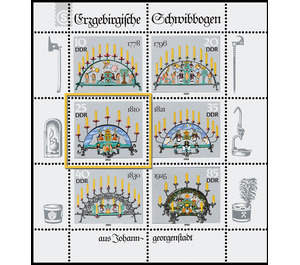Erzgebirge Schwibbogen - Germany / German Democratic Republic 1986 - 25 Pfennig
Theme: Devices, Items & Instruments
| Country | Germany / German Democratic Republic |
| Issue Date | 1986 |
| Face Value | 25.00 |
| Color | multi-colored |
| Perforation | K 14 |
| Printing Type | offset |
| Stamp Type | Postage stamp |
| Item Type | Stamp |
| Chronological Issue Number | 2801 |
| Chronological Chapter | GER-DDR |
| SID | 344428 |
| In 13 Wishlists | |
Erzgebirgische Schwibbogen from Johanngeorgenstadt The Ministry of Posts and Telecommunications of the German Democratic Republic issues six multicolored special postage stamps with illustrations of Erzgebirge Schwibbogen. The special postage stamps are printed on a miniature sheet with border design. No special first day cover envelope Special cancellation from 18 November 1986 to 17 January 1987 Schwibbogen called the Johanngeorgenstädter miners their Christmas chandeliers when they celebrated in their chewing on Stollenmundloch in contemplative round the last layer of the year. These arched candlesticks were a gift from the forge, the name comes from the hover arch of architecture. The distribution area of the Schwibbogen was limited, until fifty years ago exclusively on the Erzgebirgsort Johanngeorgenstadt. 25 Pfennig value: Schwibbogen around 1810 Since the elevation of the Saxony axis in 1806, the coat of arms of the Saxon royal family can be found on the Schwibbogen, which is held on this Schwibbogen by two mountain blacksmiths in their parade dresses. Adam and Eve were pushed onto the stem. Next to it are two miners with ore hollows on their shoulders. This specimen is 60 cm long and 39 cm high. Feet and ornamental curls are forged at the ends and provided with coarsely engraved chiselling. The vignettes of the fringe design are representational pieces of the mountain parades as well as minnows. The beard (top left) was carried by the huts on the shoulder; among officiers she moved, often richly decorated, to the main showpiece. The approximately 65 cm long spar carries a metal, beilförmiges sheet, usually with a cloverleaf cutout. Forge masters and other groups of officers wore the Steigerhöckchen (top right) stock-like in the hand. The Froschlampe (middle right) is one of the oldest mining licorice species. From a shallow dish filled with tallow or rapeseed oil, the wick sticks out on a wick holder. In the case of the Freiberger Aperture, the bulb lamp filled with rapeseed oil is protected by a wooden housing lined with bare metal (center left). At the bottom left is the hat of a forge master. Colorful feather bushes on the hats were customary only at higher officer ranks and mountain musicians (bottom right). Preservation of old miner culture and preservation of mining traditions are part of the care of our society.


